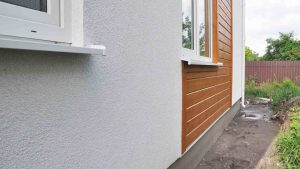External wall insulation (EWI) is a critical component of modern construction, significantly impacting energy conservation and building performance. EWI materials have undergone a remarkable evolution, reflecting broader technological, environmental, and economic trends. This article traces the progression of EWI materials from their rudimentary beginnings to the high-tech solutions of today.
Beginnings: Natural Materials
The concept of insulating walls is not new. Ancient civilisations used materials like mud, straw, and animal hides to insulate their dwellings. These natural materials provided basic thermal resistance and were a testament to the resourcefulness of early builders. However, they had limitations in durability, fire resistance, and consistent performance.
Mid-20th Century: The Rise of Synthetics
The post-World War II construction boom introduced synthetic insulation materials. Expanded polystyrene (EPS), with its exceptional insulation per unit weight and ease of installation, became a staple of EWI materials. Mineral wool, made from molten rock or slag, offered fire resistance and sound absorption, becoming a popular choice for commercial buildings.
Late 20th Century: Advancements in Foam Insulations
The energy crises of the 1970s spurred innovation in insulation materials, leading to the development of more efficient insulants like polyurethane and phenolic foams. These EWI materials offered excellent thermal resistance and were adaptable to a range of applications. The development of rigid foam boards provided a new method for insulating external walls, which could improve energy efficiency without significant structural changes.
The Shift to Sustainability
The growing awareness of environmental issues led to a renaissance in natural and recycled EWI materials. Cellulose insulation, made from recycled paper treated with fire retardants, emerged as an eco-friendly option. The industry also saw a return to natural fibers, such as sheep’s wool and cotton batts, which provided sustainable and effective insulation.
21st Century: High-Tech Solutions
The turn of the millennium heralded a new age of material science, introducing aerogels and vacuum insulation panels (VIPs). These materials pushed the boundaries of thermal performance, offering high R-values with minimal thickness. However, their adoption has been gradual due to the cost and complexity of manufacturing.
Modern Materials and Methods
In recent years, the market has settled on a mix of EWI materials that balance performance, cost, and environmental impact. Innovations like silicone renders have added to the functionality of EWI systems by providing a durable, water-resistant finish that protects the insulation and enhances the building’s aesthetic appeal.
Future Trends: Smart Materials
The horizon of EWI materials includes smart and responsive technologies. Materials that can change their properties based on temperature, such as phase change materials (PCMs), are being explored for their potential to reduce energy consumption further. These materials absorb heat as they melt and release it as they solidify, effectively acting as a thermal buffer.
The Regulatory Landscape and Its Influence
Building codes and energy standards have also played a significant role in the advancement of EWI materials. As governments worldwide introduce stricter regulations on energy efficiency, the insulation industry responds with more advanced solutions. This regulatory push has been a significant driver of innovation in the field.
Case Studies and Real-world Applications
The practical application of these materials can be seen in projects around the world. From the retrofitting of historical buildings with sensitive EWI solutions to the construction of ultra-modern structures that incorporate the latest in insulation technology, the real-world impact of these materials is vast and varied.
Conclusion
The evolution of external wall insulation materials is a narrative of innovation and adaptation. It is a field that has always responded to the needs of the time—be it for more efficient energy use, better environmental practices, or improved building performance. As we move forward, the trajectory of EWI materials will continue to be shaped by the dual imperatives of sustainability and technological advancement, ensuring that our buildings are not only more energy-efficient but also better suited to the needs of those who inhabit them.








